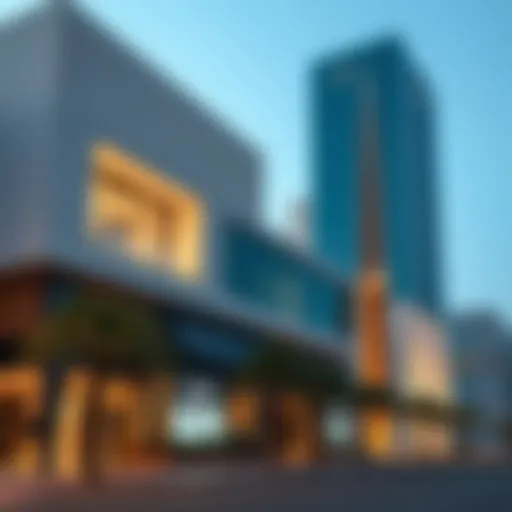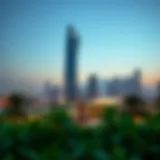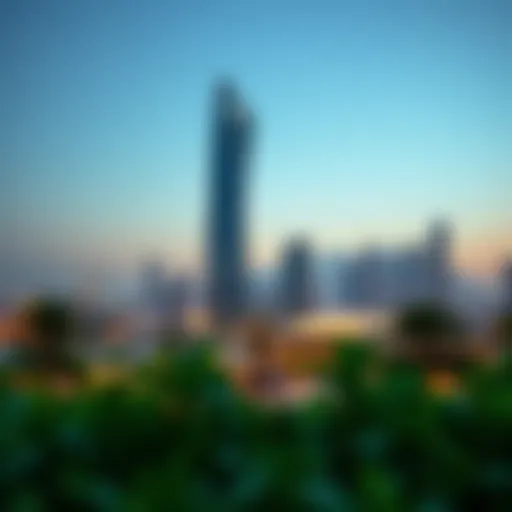Discovering Dubai's Premier Shopping Malls
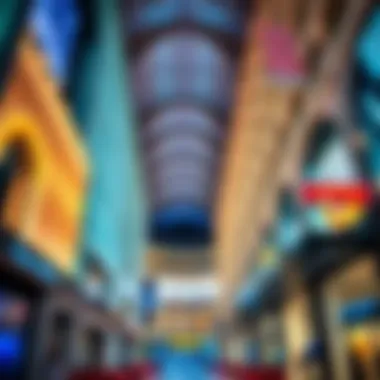
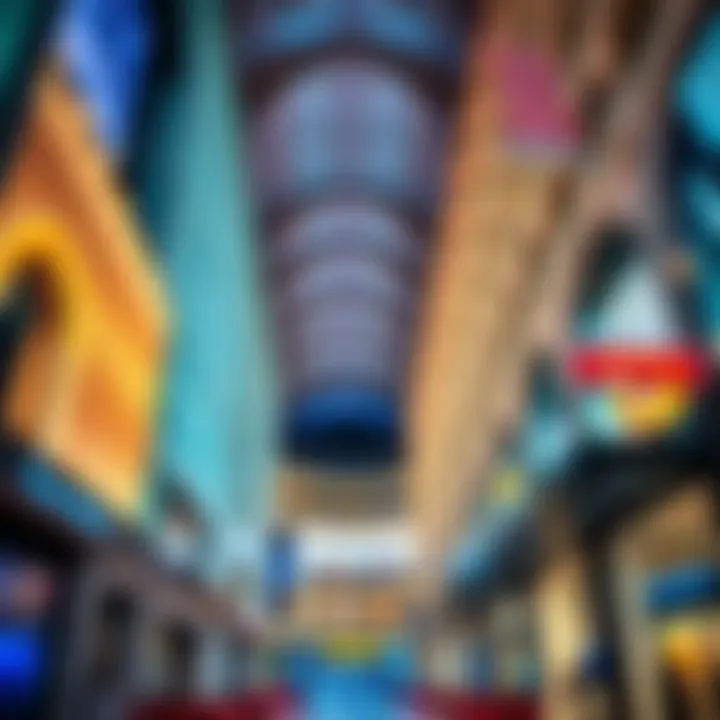
Intro
Dubai’s shopping scene stands out like a beacon of luxury and innovation, attracting visitors from around the globe. This city weaves a rich tapestry made up of towering skyscrapers, cultural enclaves, and vibrant shopping malls that redefine the retail experience. Malls in Dubai are not merely places to shop; they act as social hubs, offering a blend of entertainment, dining, and cultural experiences. The architectural prowess displayed in places like The Dubai Mall and Mall of the Emirates sheds light on the ambitions of a city that marries tradition with modernity, proving the phrase 'bigger is better' true in an extravagant sense.
As we navigate through the major shopping malls, expect to uncover their unique offerings, architectural features, and economic impact on the vibrant community of Dubai. This article endeavors to provide retail enthusiasts, investors, and residents with an insightful look into these bustling centers, a necessity for understanding Dubai’s commercial landscape.
Through the exploration of these shopping havens, we will uncover market trends, investment opportunities, and the economic implications of these retail powerhouses—like how locations such as City Walk and Ibn Battuta Mall resonate with both locals and tourists alike. It's about understanding the community dynamics and spotting potential for growth in an ever-evolving market.
Let's embark on this journey into the heart of Dubai's shopping realm.
Preface to Dubai's Retail Landscape
Dubai is often recognized as a beacon of modernity and luxury, which is vividly reflected in its vibrant retail scene. In this introduction, we will explore the unique character of Dubai's shopping malls, their enormous commercial capabilities, and how they have become integral to both local life and international tourism.
Shopping malls in Dubai are not just places to buy goods; they are social hubs that encapsulate the essence of the city. Their vast size and diverse offerings make them a magnet for both residents and tourists alike. These glamorous structures frequently boast innovative architecture and thoughtful design, providing not just a retail experience but also a cultural one. With a combination of international brands, local artisans, and niche boutiques, the retail landscape here is as varied as it is rich.
The malls often dictate the social rhythm of the city, drawing in crowds with events and promotions. For instance, numerous shopping festivals and seasonal events are held in these spaces, enhancing the overall shopping experience. The allure of these venues extends beyond mere shopping; they offer dining options, entertainment choices, and cultural experiences that contribute to the dynamic lifestyle of Dubai's citizens and visitors alike.
Thus, as we delve into the major shopping malls that define Dubai's retail landscape, we will consider not only their architectural uniqueness but also their profound cultural significance. Here, malls serve as a mirror reflecting the aspirations and tastes of a diverse populace, shaping Dubai's identity one shopping experience at a time.
Overview of Shopping Malls in Dubai
Dubai boasts an impressive array of shopping malls, each with its own unique flair and offerings. From the towering luxury of Dubai Mall to the family-oriented atmosphere of City Centre Mirdif, these malls cater to every demographic imaginable. Key features of these shopping centers often include:
- Expansive retail spaces housing global and local brands
- State-of-the-art entertainment facilities, such as cinema complexes and indoor ski parks
- Dining options ranging from fast food to fine dining establishments
The scale of these shopping spaces is often awe-inspiring. For example, Dubai Mall features over 1,200 retail stores, making it one of the largest malls in the world. It is more than just a place to shop; it envelops visitors in a complete sensory overload of sights, sounds, and experiences.
Cultural Significance of Malls
Shopping malls in Dubai are not simply commercial entities; they are cultural landmarks that reflect the city's rapid evolution and its diverse society. They act as social equalizers where people from different walks of life converge. In many ways, they embody the melting pot that is Dubai.
Here are a few cultural highlights:
- Community Events: Malls often host cultural events, festivals, and exhibitions that celebrate local heritage and bring the community together.
- Art Installations: Many malls feature art exhibitions that showcase the works of local artists, contributing to the city’s thriving art scene.
- Culinary Diversity: Through an eclectic mix of restaurants and cafes, malls allow visitors to savor global cuisines, reflecting the multicultural fabric of Dubai.
In essence, these shopping centers function as microcosms of Dubai itself, where commerce and culture thrive side by side. They are places where personal stories unfold, memories are made, and community ties are strengthened, proving that in Dubai, shopping is not just a matter of retail but a matter of lifestyle.
Dubai Mall: The Pinnacle of Luxury
Dubai Mall represents not just a shopping complex, but a beacon of luxury that encapsulates the splendor and vibrancy of Dubai itself. As one of the largest malls in the world, it serves as a microcosm of global retail culture and a social hub for residents and tourists alike. This section emphasizes the significance of the Dubai Mall within the broader context of shopping in the city, showcasing its exceptional elements and unmatched offerings, making it an essential highlight in any discussion about Dubai's retail landscape.
Architectural Features
The architectural design of Dubai Mall is nothing short of breathtaking. Spanning a staggering 1,124,000 square meters, its layout exudes grandeur at every turn. The main entrance, flanked by lush greenery and artistic fountains, sets the tone for an ethereal experience before visitors even step inside. The mix of contemporary style with traditional influences is displayed through stunning glass panels that allow natural light to flood the interior. What stands out is the impressive atrium which houses a gigantic aquarium – one of the largest suspended aquariums in the world.
"The Dubai Mall isn’t just a shopping destination; it’s a work of art in its own right."
Would-be visitors find it difficult to miss the iconic Burj Khalifa towering adjacent. This harmony of design between the mall and the tower further enhances the luxurious aura. Attention to detail is evident everywhere, from the carefully curated art installations to the striking LED displays that dazzle as dusk falls.
Retail Experience
Walking through the Dubai Mall is akin to embarking on a journey through luxury retail. The mall hosts over 1,200 shops, featuring everything from haute couture brands such as Chanel and Gucci to popular high street names. Each outlet reflects the meticulous attention to detail and premium offerings that characterize Dubai Mall.
For retail enthusiasts, the blend of high-end boutiques with flagship stores creates a shopping experience that is both eclectic and exclusive. Beyond shops, personalized services, such as personal shopping assistants, elevate customer service to an art form. It’s where one can sip on gourmet coffee while browsing through the latest collections. Overall, the Dubai Mall distinguishes itself through its capability to turn shopping into an experience marked by comfort and indulgence.
Tourist Attractions Within
The Dubai Mall is not just an epicenter for shopping but also a treasure trove of attractions that cater to a wider audience. Among the key attractions is the Dubai Aquarium & Underwater Zoo, where visitors can marvel at marine life and even go cage diving with sharks. This engaging experience adds to the allure of the mall, drawing families and thrill-seekers alike.
Then there’s the Dubai Ice Rink, perfect for fans of winter sports, all housed within a warm desert climate. Additionally, the at the mall features an indoor theme park, SEGA Republic, which invigorates the atmosphere with its rides and games for all ages.
Moreover, for those seeking entertainment, the mall regularly hosts events, shows, and exhibitions, ensuring there’s always something new to explore. A visit to Dubai Mall isn’t merely about shopping; it’s a full day’s worth of entertainment and culture, appealing to both local residents and travelers.
In summary, the Dubai Mall stands as an icon of luxury in the shopping realm of Dubai. Its architectural beauty, unique retail experience, and rich offerings of attractions create an unmatched destination that attracts millions each year, reinforcing Dubai's position as a global city.
For further reading and exploration, one might visit resources like Wikipedia or delve into detailed reviews on platforms like Reddit.

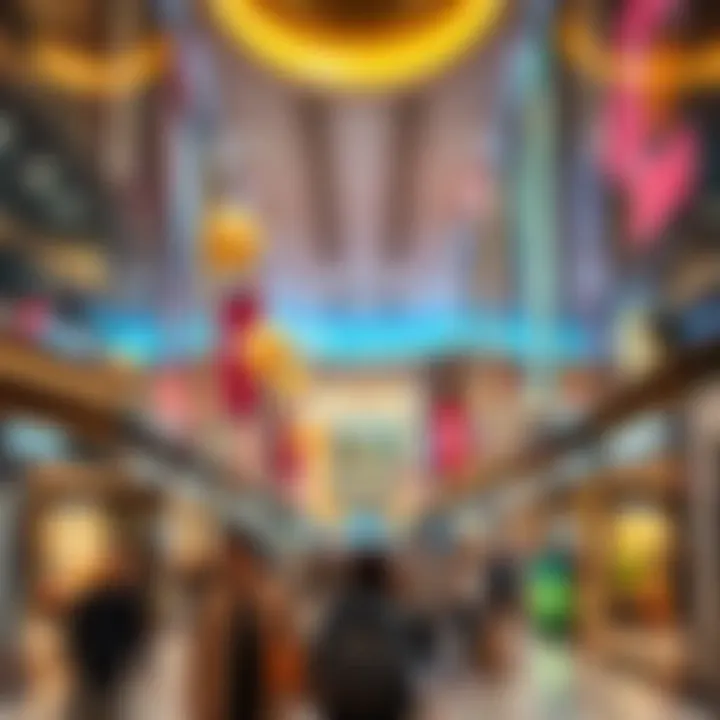
Mall of the Emirates: A Comprehensive Review
The Mall of the Emirates stands out as one of Dubai's most prominent shopping destinations. It is not just a mall; it's a sophisticated hub that captures the intricate weave of retail, leisure, and culture. Located in Al Barsha, this mall is a key player in Dubai's retail landscape, attracting both locals and tourists alike. This section highlights the characteristics that make the Mall of the Emirates a vital element of this article.
Ski Dubai and Its Impact
Ski Dubai is a particularly unique feature of the Mall of the Emirates. Opened in 2005, it is an indoor ski resort that offers a striking contrast to the city's arid climate. Spanning 22,500 square meters, this facility allows visitors to enjoy skiing, snowboarding, and even to meet penguins in a controlled, snowy environment. For many tourists, it represents a chance to experience winter sports without leaving the desert.
Ski Dubai has also significantly impacted the regional tourism market. By offering a winter wonderland, it pulls in crowds who may not have otherwise visited. It's a prime selling point for the mall and boosts surrounding businesses. Local enthusiasts, too, benefit; they can indulge in winter sports within the confines of one of the world's hottest cities. This unique offering not only boosts footfall but also positions Mall of the Emirates as a distinctive attraction.
Diverse Shopping Options
When it comes to retail variety, the Mall of the Emirates does not disappoint. Housing over 600 retail outlets, it ranges from high-end luxury brands like Gucci, Chanel, and Louis Vuitton to more accessible options such as H&M and Zara. The mix allows a diverse demographic, from affluent shoppers to budget-conscious ones, to find what they need under one roof.
Furthermore, the mall features a wide array of local and international brands. If you’re on the lookout for Emirati crafts, there are artisanal stores that showcase intricate handmade products. For tech lovers, renowned stores like Apple and Samsung offer the latest gadgets and gizmos.
The shopping experience here goes beyond just pure retail therapy. Many stores are designed to entice customers through innovative setups that change periodically, keeping the environment fresh and exciting. There are also several marketing events held throughout the year, including seasonal sales and celebrity appearances, which keep consumers coming back.
Entertainment Facilities
The entertainment choices at the Mall of the Emirates augment its appeal as a full-fledged destination. Beyond Ski Dubai, the mall features VOX Cinemas, which showcases the latest films in luxurious settings. Offering plush seating and a variety of snacks, it creates a cinematic experience that enhances the allure of a day out shopping.
For family outings, Magic Planet—a multi-level family entertainment center—provides arcade games, rides, and attractions designed to keep children entertained. It offers everything from bumper cars to virtual reality experiences. These attractions not only make the mall a fun place for families but add commercial viability by drawing in younger audiences on weekends and holidays.
In addition to these venues, there are often exhibitions and live performances that take place in various spaces within the mall, making it a vibrant environment.
"Mall of the Emirates is not just about shopping; it’s about experiences that engage the whole family."
In summary, the Mall of the Emirates is a microcosm of Dubai's retail dynamism. From its unique Ski Dubai attraction to diverse shopping opportunities and state-of-the-art entertainment facilities, the mall vividly illustrates how shopping can intertwine with leisure. For investors interested in the commercial real estate sector, understanding how such elements come together is crucial for future opportunities in the landscape of Dubai's retail growth.
City Centre Mirdif: A Local Favorite
City Centre Mirdif stands out as a favorite shopping destination among locals, providing a distinct blend of shopping, leisure, and community-focused experiences. This mall is not just another retail giant in Dubai's bustling commercial landscape; it has carved its own niche by fostering a sense of belonging among residents. The positive buzz around City Centre Mirdif often revolves around its ability to blend modern shopping experiences with community engagement, making it a pivotal point for many families and individuals.
Community Engagement Initiatives
City Centre Mirdif takes pride in its community outreach programs, which contribute tremendously to its reputation. Regularly hosting events tailored for residents of all ages, the mall does more than just satisfy retail needs; it nurtures local connections. Initiatives often include:
- Seasonal Festivals: During holidays, the mall rolls out family-friendly events that promote cultural diversity and celebrate traditions.
- Workshops and Classes: From cooking demonstrations to art classes, the mall provides a platform for enthusiasts to learn and showcase their talents.
- Support for Local Businesses: City Centre Mirdif collaborates with local artisans, offering them a venue to sell their goods, thus enriching the shopping experience with authentic community products.
These efforts not only amplify foot traffic but also create a welcoming environment. Visitors often find themselves lingering longer, enjoying the events spread throughout the year.
Family-Friendly Amenities
In addition to being a community hub, City Centre Mirdif is designed with families in mind. The range of family-friendly amenities caters to both parents and children, making it an ideal destination for a day out. Key offerings include:
- KidZania: This interactive edutainment center allows children to explore different professions in a role-playing environment, merging play with learning.
- Magic Planet: An entertainment zone featuring arcade games, rides, and attractions that keep kids entertained for hours.
- Family Restrooms & Nursing Rooms: Thoughtful touches such as changing facilities and nursing rooms reassure parents, emphasizing comfort within the shopping experience.
By integrating such amenities, City Centre Mirdif ensures that a shopping trip can easily transform into a delightful family outing. The mall's design promotes accessibility, allowing parents and children to navigate seamlessly while enjoying quality time together.
"City Centre Mirdif is more than just a shopping mall; it's a gathering place that brings the community together and offers experiences that resonate with both locals and visitors."
Overall, City Centre Mirdif's strategic emphasis on community engagement and family-friendly facilities contribute significantly to its status as a local favorite. By blending shopping with meaningful interactions and experiences, it stands as a testament to Dubai's evolving retail landscape.
Ibn Battuta Mall: A Cultural Journey
Ibn Battuta Mall stands as a testament to Dubai’s unique blend of history, culture, and modernity. Named after the famous 14th-century Moroccan explorer, this mall not only offers an array of shopping options but also takes visitors on a journey through various cultures and civilizations. The mall is a reflection of Dubai’s passion for embracing diversity while showcasing global heritage through its architecture and thematic presentations. It's not merely a shopping center but a cultural hub that invites locals and tourists alike to explore the stories of ancient routes and traditions.
Themed Areas and Their Importance
When one steps into Ibn Battuta Mall, they are greeted by beautifully designed themed sections that replicate regions explored by Ibn Battuta himself. These themed areas - the Andalusia, Tunisia, Egypt, Persia, India, and China sections - are more than aesthetic choices; they play a crucial role in how the mall engages its visitors.
- Cultural Immersion: Each section's design immerses visitors in the corresponding culture it represents. For instance, the Andalusian section features intricate tile work, archways, and fountains, creating an inviting atmosphere reminiscent of historic Spain.
- Educational Value: The mall serves as an informal educational platform. Informative plaques and displays throughout the themed areas detail the stories and historical significance behind the architecture and its connection to Ibn Battuta’s travels. This blend of culture and commerce educates shoppers while they browse.
- Unique Shopping Experiences: Each section also houses shops that reflect the culture of the region. For instance, you can find artisanal products unique to India or culinary delights from Tunisia. This variety not only diversifies the shopping experience but also supports local artisans and merchants.
Visitors are encouraged to take their time, appreciate the detailed craftsmanship, and enjoy a unique shopping ambiance that goes beyond mere transactional purchases.
Retail Offerings and Unique Stores
In terms of retail variety, Ibn Battuta Mall does not drop the ball. Home to over 270 retail outlets, it offers everything from high-street fashion to specialty boutiques that cater to niche markets.
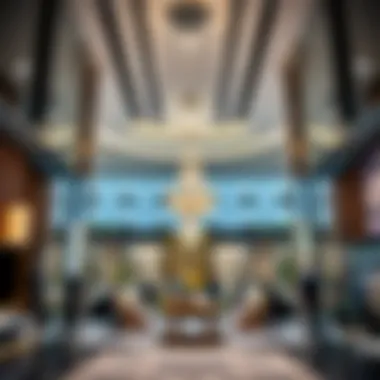
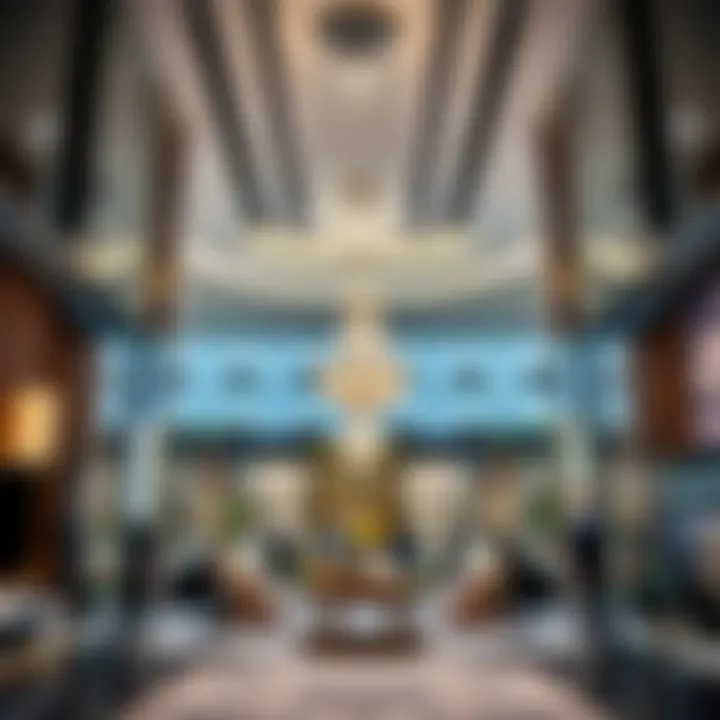
- Major Brands: You can find well-known global brands like Nike, Adidas, and Zara here. These familiar names draw in crowds, maintaining a strong footfall and a vibrant shopping atmosphere.
- Local Artisans: Beyond the big names, the jewellers, handicraft stores, and boutiques offer local artistry. Shops featuring Arabic calligraphy, handmade crafts, and unique home decor reflect the rich cultural tapestry of the region, inviting consumers to take home a piece of Dubai.
- Dining Options: In addition to retail, the mall presents food courts and restaurants that offer a blend of international cuisines. These establishments highlight the diversity and culinary richness of the cultures represented, from Chinese dumplings to Indian curry.
In essence, Ibn Battuta Mall serves as a cultural crossroads, where shopping intersects with heritage, making it an essential stop for both retail therapy and cultural exploration.
"Ibn Battuta Mall embodies the essence of Dubai: a crossroads of cultures, where everyone can find a story worth sharing."
In the heart of the retail scene, this mall has created an atmosphere where each visit feels unique, underscoring its commitment to cultural representation and economic vitality.
For further readings on the impact of malls and their integration into the cultural framework of Dubai, check out resources like Wikipedia or Britannica.
As the landscape of Dubai evolves, Ibn Battuta Mall remains a glowing example of how shopping can be interwoven with rich cultural storytelling.
Dubai Festival City Mall: A Modern Oasis
Dubai Festival City Mall stands as a beacon of retail innovation and leisure, meticulously designed to cater to the diverse tastes of both residents and tourists. This establishment is not just another shopping center; it signifies a shift in how Dubai's retail landscape is evolving, highlighting the importance of integrating leisure, culture, and shopping in one seamless experience.
The mall's strategic location along the banks of the Dubai Creek provides stunning waterfront views, making it a unique oasis of relaxation and vibrancy in a bustling city. It serves as a crucial point of convergence for families, friends, and tourists seeking a place to shop, dine, and unwind, fostering a sense of community and enjoyment in the heart of Dubai.
Waterfront Views and Accessibility
The allure of Dubai Festival City Mall is heightened by its breathtaking waterfront views. Visitors are treated to panoramic vistas that complement the shopping experience. Being adjacent to the picturesque Dubai Creek, the mall offers ample opportunities for leisurely strolls along the waterfront, creating an inviting environment for those wanting to take a breather from their retail explorations.
Accessibility is another feather in the cap of this shopping haven. Located just a short drive from the Dubai International Airport, it attracts both locals and international visitors effortlessly. The mall is well-connected via the Dubai Metro, with dedicated bus services and ample parking, ensuring that reaching this oasis is a breeze. The user-friendly layout inside the mall allows shoppers to navigate through a diverse range of stores without feeling overwhelmed, enhancing the overall shopping experience.
Annual Events and Festivals
What truly differentiates Dubai Festival City Mall from the herd is its commitment to community engagement through a vibrant series of annual events and festivals. These gatherings not only draw larger crowds but also create a festive atmosphere that resonates with the spirit of Dubai's cultural landscape.
Some of the notable events include:
- Dubai Shopping Festival: An annual highlight featuring discounts, entertainment, and local art.
- Festivities for UAE National Day: Celebrating the rich history and heritage of the emirates with special events and displays.
- Seasonal Festivals: Such as Ramadan nights and Eid experiences, which transform the mall into a hub of cultural festivities.
During such occasions, the mall often hosts live performances, art installations, and workshops, allowing visitors to immerse themselves deeper into the vibrant local culture. This fosters a stronger bond between the mall and the community, reinforcing its role as a central cultural icon in Dubai.
Overall, Dubai Festival City Mall represents more than mere shopping—it embodies a lifestyle choice where accessibility, beauty, and cultural experiences converge, making it a modern oasis in the desert. For real estate investors, it showcases the potential benefits of integrated retail developments within the urban fabric, serving as a model for future projects.
Shopping Centre Comparison
Understanding the landscape of shopping malls in Dubai requires not only an exploration of individual centers but a thoughtful comparison of their unique attributes. This section sheds light on critical factors such as foot traffic and visitor demographics, as well as the trends that ripple through Dubai's retail scene. Such comparisons are vital for stakeholders in real estate and retail sectors, seen as avenues for investment and strategic development.
Foot Traffic and Visitor Demographics
Dubai’s shopping centers are bustling hubs that attract a diverse range of visitors, each with unique spending habits and interests. Analyzing foot traffic can provide a peek into a mall's popularity and efficiency.
- Peak Times: Shopping malls tend to draw in larger crowds on weekends and public holidays. During the shopping festivals, notably the Dubai Shopping Festival, these numbers can skyrocket. Such patterns are crucial for retailers deciding on operational hours or promotional events.
- Visitor Segments: Understanding who walks through the doors gives insight into shopping trends. Tourists, being major contributors, typically favor luxury brands found in the Dubai Mall, while local families might frequent places like City Centre Mirdif for convenience and family-oriented activities.
- Demographic Insights: Data on visitor demographics can be transformative. Malls like Mall of the Emirates often see a mix of affluent local residents and expatriates, whereas Ibn Battuta may attract a younger crowd more inclined to shop from unique, culturally themed stores.
In essence, recognizing patterns related to foot traffic and demographic nuances aids in aligning retail strategies with consumer behavior, thus maximizing the potential of each shopping center.
Retail Trends Across Malls
As consumer preferences evolve, the retail landscape within Dubai’s malls shifts accordingly. Spotlighting these trends not only becomes a lens through which one can gauge economic health but also a roadmap for what’s to come.
- Experiential Retail: Many malls have embraced an experiential approach, going beyond just sales for profit. For instance, Ski Dubai at Mall of the Emirates revolutionizes the shopping experience by merging retail with entertainment, keeping customers engaged for longer periods.
- E-commerce Integration: Recognizing the significant shift towards online shopping, many malls are now blending physical and digital experiences. Various retailers offer in-store pickups for online orders, harmonizing both realms.
- Sustainability Efforts: Greener practices are gaining traction, with shopping centers implementing eco-friendly initiatives to attract a socially conscious clientele. This includes installing solar panels and waste reduction programs, appealing not just to a niche audience but broadening their market appeal.
These evolving trends underscore the need for continuous adaptation in a fast-paced environment. Retailers who can swiftly respond to changing consumer preferences stand a better chance at thriving in Dubai's competitive mall scene.
Ultimately, the shopping center comparison encapsulates much more than just numerical data; it provides a holistic view into the vibrant dynamics of Dubai's retail ecosystem.
Economic Impact of Shopping Malls
The role of shopping malls in Dubai goes beyond mere consumer spaces; they are pivotal to the city’s economic framework. Understanding the economic impact of these malls helps illustrate their integral part in shaping Dubai's retail landscape and broadening its appeal to international tourists and investors alike. With Dubai becoming a global hub, the influence of shopping centers is manifold, impacting tourism, local businesses, and the job market.
Role in Dubai's Tourism Industry
Dubai’s malls are not just about shopping; they contribute significantly to the tourism industry. Tourists flock to these retail havens not only for shopping but for the entire experience they offer. Major malls like the Dubai Mall and Mall of the Emirates are characterized by
- Attractive architecture that draws visitors.
- Variety of entertainment options, including ice skating rinks and indoor ski slopes.
- Culinary experiences ranging from local delights to fine dining.
It's estimated that millions of tourists visit these malls every year. Their appeal is so strong that a visit to a mall has become a common part of a tourist's itinerary in Dubai. For instance, Dubai Mall has nearly 80 million visitors annually, making it one of the most-visited shopping destinations globally.

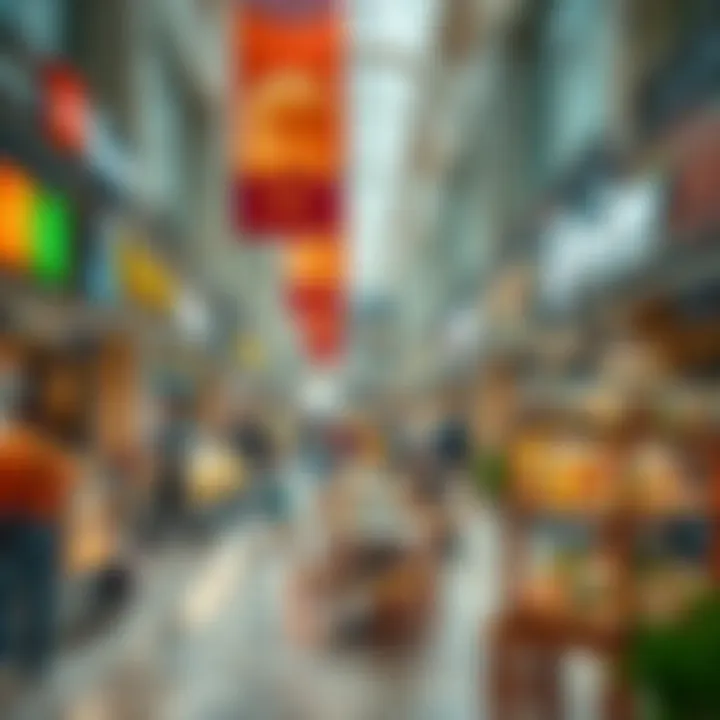
In this context, malls are more than retail spaces; they are attraction centers that enhance the city’s image as a cosmopolitan destination. Tours and events often leverage these malls, creating a bustling atmosphere that drives continued patronage and revenue.
"Dubai's malls turn visitors into spenders, ensuring the economic wheels keep turning, not just for retailers but for the entire tourism ecosystem."
Contribution to Local Employment
The impact of shopping malls extends significantly into the job market in Dubai. Building, operating, and maintaining shopping centers create a plethora of job opportunities. These employment roles can be categorized into several sectors:
- Retail Jobs: From cashiers to sales assistants, thousands find employment in the stores spread across the malls.
- Hospitality Roles: With eateries and cafes, a diverse range of jobs in catering, waiting staff, and management arise.
- Maintenance and Security: Malls require maintenance staff and security personnel to ensure a safe and pleasant environment for shoppers.
- Administrative Positions: From managerial roles to marketing teams, these positions are essential for smooth operations.
The contribution to local employment is significant. Reports indicate that malls in Dubai collectively employ tens of thousands of individuals, helping to reduce unemployment rates. Furthermore, many of these positions are filled by residents of Dubai, amplifying local economic growth. Essentially, shopping malls act as a catalyst for employment, fueling not only the retail sector but affecting ancillary industries as well.
In summary, the economic impact of shopping malls in Dubai is not one-dimensional. They are crucial players in promoting tourism and fostering job creation, proving that their influence extends well beyond the shopping experience.
Real Estate Implications of Malls
The landscape of Dubai’s shopping malls extends beyond consumption and leisure; it weaves into the very fabric of the city’s real estate dynamics. Understanding the implications these malls have on surrounding neighborhoods and overall property markets can offer valuable insights for investors and developers alike. The blend of commerce, tourism, and urban development has crafted an environment where shopping centers aren't just retail hubs; they are key players in the real estate game.
Investment Opportunities Linked to Retail Spaces
Retail spaces within malls present a unique opportunity for investors, especially in a vibrant market like Dubai. The sheer volume of foot traffic driven by malls attracts retailers from around the globe, creating a compelling business ecosystem. Here’s why investing in these spaces can be a fruitful endeavor:
- High Demand for Retail Spaces: The continuous influx of tourists and the spending habits of residents assure a steady demand for retail stores.
- Diverse Tenant Mix: Malls typically curate a mix of international brands and local businesses, enhancing attractiveness to different shopper demographics. This diversity often leads to greater stability in rental income.
- Long-Term Leases: Retailers in premier malls often sign long-term leases, which can provide investors with reliable revenue streams.
- Greater Exposure: Retail spaces situated in malls benefit from increased visibility and foot traffic as opposed to standalone stores, translating to higher sales potential.
As developers eye opportunities, understanding local real estate trends is crucial. For instance, areas adjacent to malls often experience increased demand for residential and commercial properties, as accessibility becomes a premium selling point.
Impact on Surrounding Property Values
The presence of large shopping malls invariably affects the property values in their vicinity—typically driving them upwards. When malls are well-managed and feature a variety of high-quality retail and entertainment options, they can significantly elevate nearby property prices. Here are some factors to consider:
- Increased Demand for Housing: With higher standards of living and more amenities, demand for housing nearby malls can spike. Properties nearby often see appreciation due to the convenience offered.
- Enhanced Infrastructure: Malls usually catalyze improvements in local infrastructure, such as roadways and public transportation, enhancing accessibility and thus promoting further development.
- Social Amenities: Shopping malls attract ancillary services like restaurants, gyms, and leisure facilities, fostering a vibrant community. This increase in amenities can further enhance property values in the area.
- Community Revitalization: Over time, properties in the surrounding districts may undergo renovation or redevelopment, influenced by the thriving commercial activity. This can transform neighborhoods and uplift property values significantly.
The ripple effect of a mall's presence on property values speaks volumes to investors looking for lucrative real estate prospects.
Future Trends in Dubai's Retail Sector
As the vibrant heart of shopping in Dubai continues to evolve, understanding the future trends in the retail sector becomes essential. The interplay between innovation and tradition shapes how consumers engage with malls. Knowing these developments is crucial for investors, developers, and anyone keen on making informed decisions in this bustling marketplace.
Integration of E-commerce with Brick-and-Mortar Stores
The rise of e-commerce has not gone unnoticed in the sprawling malls of Dubai. Shoppers today often start their journey online, browsing products and prices before stepping foot in physical stores. This shift demands that brick-and-mortar shops adapt by integrating technology for a seamless experience. Retailers are exploring ways to merge the two worlds, offering services like click-and-collect, where customers can order online and easily pick up in-store.
Moreover, augmented reality has started to take root, allowing shoppers to visualize products in real-life contexts before making a purchase. For instance, furniture stores in malls might enable customers to use their smartphones to see how a couch would look in their living rooms, reducing the chance of buyer's regret. This connection not only drives sales but enhances customer satisfaction.
Sustainable Practices in Mall Management
In the modern era, sustainability is no longer just a buzzword; it has become a pressing necessity, especially in a rapidly growing city like Dubai. Mall management is evolving to prioritize eco-friendly practices that meet both consumer expectations and regulatory standards.
Many shopping centers in Dubai are now incorporating green building certifications that help in reducing their carbon footprint. For example, energy-efficient lighting, recycled water systems for landscaping, and waste management programs are becoming standard practice.
Notably, some malls are introducing dedicated spaces for local artisans and eco-conscious brands. This approach not only supports community ventures but also aligns with the growing consumer base that values sustainable shopping options. Consumers today want to make choices that reflect their values, and malls have picked up on that.
"Sustainability in retail not only mitigates environmental impact but also enhances brand loyalty among increasingly conscious consumers."
In summary, as the retail landscape in Dubai transforms, the emphasis on integrating e-commerce with traditional retailing and adopting sustainable practices emerges as key trends. Investors and developers must stay attuned to these shifts, ensuring they are well-positioned to capitalize on the evolving preferences of consumers.
By focusing on these trends, the pièce de résistance that many shopping malls in Dubai aim for is a harmonious blend of technology and sustainability, reflecting the aspirations of a new generation of shoppers.
Through these lenses, we can glean a clearer picture of what the future holds for Dubai’s retail sector— a sector that is bold, innovative, and ever-adapting.
Closure: The Role of Malls in Dubai's Urban Fabric
Dubai's shopping malls do more than just sell products; they are pivotal to the identity and social fabric of its urban landscape. In a city known for its ambitious architecture and thriving economy, malls act as vital hubs that fuse commerce, entertainment, and community engagement. They are symbolic of Dubai's growth and serve as gathering places where residents and tourists alike come to experience the vibrant culture that the city offers.
These shopping centers are intricately linked to the urban planning and development of Dubai. With their colossal sizes and diverse offerings, malls serve as landmarks that draw visitors and stimulate local economies. Malls like the Dubai Mall and Mall of the Emirates encapsulate how commercial spaces can integrate seamlessly with lifestyle and luxury. Here's an interesting fact: The Dubai Mall, alone, houses over 1,200 retail outlets, not to mention an elaborate selection of dining and entertainment options. This variety showcases both global brands and local delights, creating a unique shopping experience that caters to all tastes.
Synthesis of Insights
Reflecting on the insights gathered from the diverse shopping malls, one can appreciate their multifaceted role. These venues do not merely serve the purpose of shopping; instead, they foster a sense of community and play a significant role in enhancing the quality of urban life. Malls often organize events that promote local talent, such as exhibitions, cultural showcases, and seasonal festivities, furthering their relationship with the community. This engagement highlights the symbiotic bond between malls and the local populace, making them feel connected and invested in these commercial spaces.
Moreover, considering the economic implications, it’s evident that shopping centers are crucial anchors in Dubai’s tourism sector. They attract millions of tourists each year, contributing to the overall foot traffic in the city and increasing the visibility of surrounding real estate. Their influence extends beyond just shopping; they impact investment opportunities and the overall dynamism of the local economy.
Final Thoughts
The future of retail in Dubai seems bright, captured within these sprawling spaces that reflect the spirit of this remarkable city. For real estate agents, investors, and developers, understanding the implications of shopping malls—from their architectural grandeur to their economic impact—is vital for navigating the vibrant landscape of Dubai’s commercial sector. It's clear that malls are more than just places to shop; they are essential threads woven into the very fabric of Dubai.





